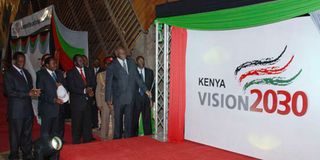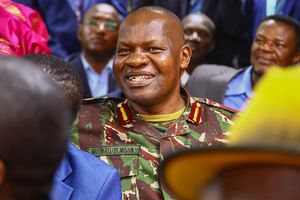Revisit Kenya Vision 2030 for sustainability

President Mwai Kibaki (right) with Prime Minister Raila Odinga (third left), vice-president Kalonzo Musyoka (second left) and Planning minister Wycliffe Oparanya when they unveiled the Vision 2030 logo at KICC, Nairobi, in 2008.
The four key transformative priority initiatives in the second phase of the Kenya Vision 2030 development blueprint are food security and nutrition, universal health coverage (UHC), affordable housing and manufacturing.
But due to various political and economic challenges, Kenya has not been able to achieve much of the key initiatives aimed at transforming it to an upper middle-income industrialised country that can offer a high quality of life to all its citizens in a clean and secure environment by 2030.
Launched in 2008 by then-President Mwai Kibaki, Vision 2030 emphasized fundamental development pillars and outlined implementation procedures of plans for a globally competitive and prosperous country with a high quality of life by 2030.
The blueprint was motivated by a collective aspiration for a better society and based on three pillars: Economic, social and political.
These were anchored on foundations such as enhanced equity and wealth creation, opportunities for the poor, infrastructure, macroeconomic stability, technology and innovation and continuity in governance.
To amicably address some of the hurdles the country faces, we need to use a similar process and methodology as proposed by the vision’s experts.
We should appreciate our situation and identify projects and priorities in the social and political sectors through detailed analysis in a consultative process to come up with strategies capable of resolving the current social and political problems and arrive at workable solutions.
Proposals from all stakeholders
The affordable housing program and UHC, implemented through an effective National Health Insurance Fund (NHIF), are crucial for the country’s development, improving livelihoods and making Kenya a better society.
But we need extensive use of information and proposals from all stakeholders—including civil society, universities, youth, private sector and government employees—for success.
Inflation, prolonged drought in most parts of the country and Covid-19 are among the issues that have slowed the economy from growing rapidly and disrupted the vision. But the country could still achieve its long-term development objectives outlined in Vision 2030, including those that are being championed by President William Ruto to improve the lives of people in a short period.
For the country to thrive economically, we should all focus on creating an environment that unlocks business opportunities and broadens the economic base and come up with concerted strategies to attract investors and create jobs for the majority of youth to solve the unemployment problem.
Through consultations on its programmes for empowering citizens, the government will have an in-depth understanding of the country’s development problems and the necessary strategies to achieve its goals transparently and effectively.
Mr Chitwa is a communication officer with the Uasin Gishu County government. [email protected].





